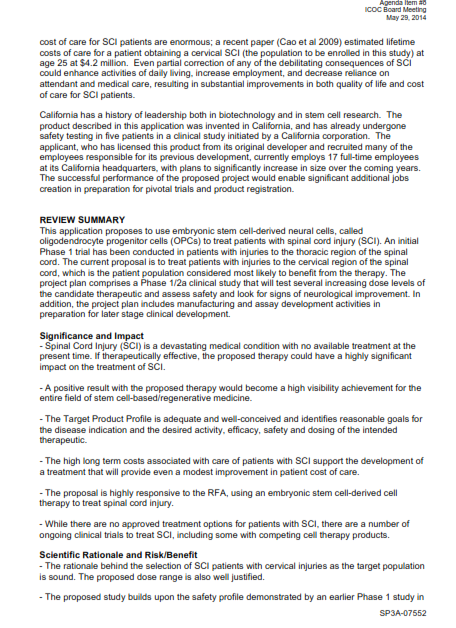Directors of the California stem cell
agency tomorrow are scheduled to deal once again with a $900,424 proposed award to a Stanford researcher who recently hired a top
staffer from the state research effort.
The award would go to
Helen
Blau, one of the leaders of
Baxter Laboratory at
Stanford. On Monday,
Natalie DeWitt, who was special projects officer for former
CIRM
President
Alan Trounson, went to work for Baxter as director of research
development.
The award first came up at the
directors' meeting May 29. It was recommended for board approval by
Trounson and unidentified CIRM staff.
During that meeting, CIRM Director Jeff
Sheehy, who is also a member of the grant review group, said that a copy
of the application and the scientific critique was not provided to
him at the March 24 review session. The application was submitted by Blau in
January.
Sheehy and another director said the
review was flawed. Sheehy noted that the Blau proposal was not
approved for funding by the agency's out-of-state scientific
reviewers. He said that during the closed-door review session several negative comments were made about the
proposal during oral discussion. The application
received a scientific score of 73, two points below the cut-off for
funding. CIRM staff said, however, the proposal had merit and should
be funded.
Director Sherry Lansing said it was
important for the board to be open and transparent and suggested that
the application be sent back to the full review group for further consideration. The 29-member board
did so on a 9-0 vote. Members not voting either had conflicts of
interest or were not present.
At the time of the meeting, DeWitt's then future employment by
Baxter was not widely known and was not mentioned during
the discussion.
In response to questions, CIRM spokesman Kevin McCormack today said in
an email that DeWitt was not involved with the $900,424 application
by Blau. He said DeWitt served notice May 19. DeWitt said that
sometime in late April or May that she “let a few key people (at the
agency) know” that she was looking for work elsewhere and “spoke with
the (CIRM) lawyers.”
DeWitt said her work at CIRM involved
the $70 million Alpha Clinic proposal and the $40 million stem cell
genomics award that went to a Stanford-led consortium. She said
Baxter's Peter Jackson, who has some expertise in human genetic
disease, is not involved in the genomics proposal. The CIRM contract
on the award is yet to be signed.
DeWitt was mentioned yesterday
in an article on the California Stem Cell Report dealing with
“revolving door” issues involving government employees who go to
work for enterprises that are linked to their former agency. The
issues are likely to become of more concern to the stem cell agency
in the next couple of years. The agency is scheduled to run out of
money for new grants in 2017, and some employees are likely to be
looking for work in the stem cell field in California, which only
involves a small number of private and public enterprises.
CIRM employees are briefed on
conflict-of-interest and revolving door issues, according to the
agency. Its employee handbook also contains
information on the subject along with a link to a state Fair
Political Practices Commission document further explaining revolving
door rules.
It says state officials are barred from
taking part in decisions that directly relate to a prospective
employer. The document says,
“The ban of influencing prospective
employment prohibits any public official from making, participating
in making, or influencing a governmental decision that directly
relates to a prospective employer while negotiating or after reaching
an employment arrangement.”
It continues,
“The ban
on influencing prospective employment is triggered by negotiating or
having an arrangement regarding prospective employment. While
submitting a résumé or an application to a prospective employer
does not trigger the ban, the following contacts will trigger the
ban:
- “An interview with an employer or his
or her agent.
- “Discussing an offer of employment
with an employer or his or her agent.
- “Accepting an offer of employment
In response to a question, McCormack
said,
“Very few people, Natalie included,
tell their employer that they are looking for work so I have no idea
when she started looking.”
McCormack did not respond to a request
for the names of the CIRM staff involved in making the recommendation
to approve the $900,424 Blau award.








